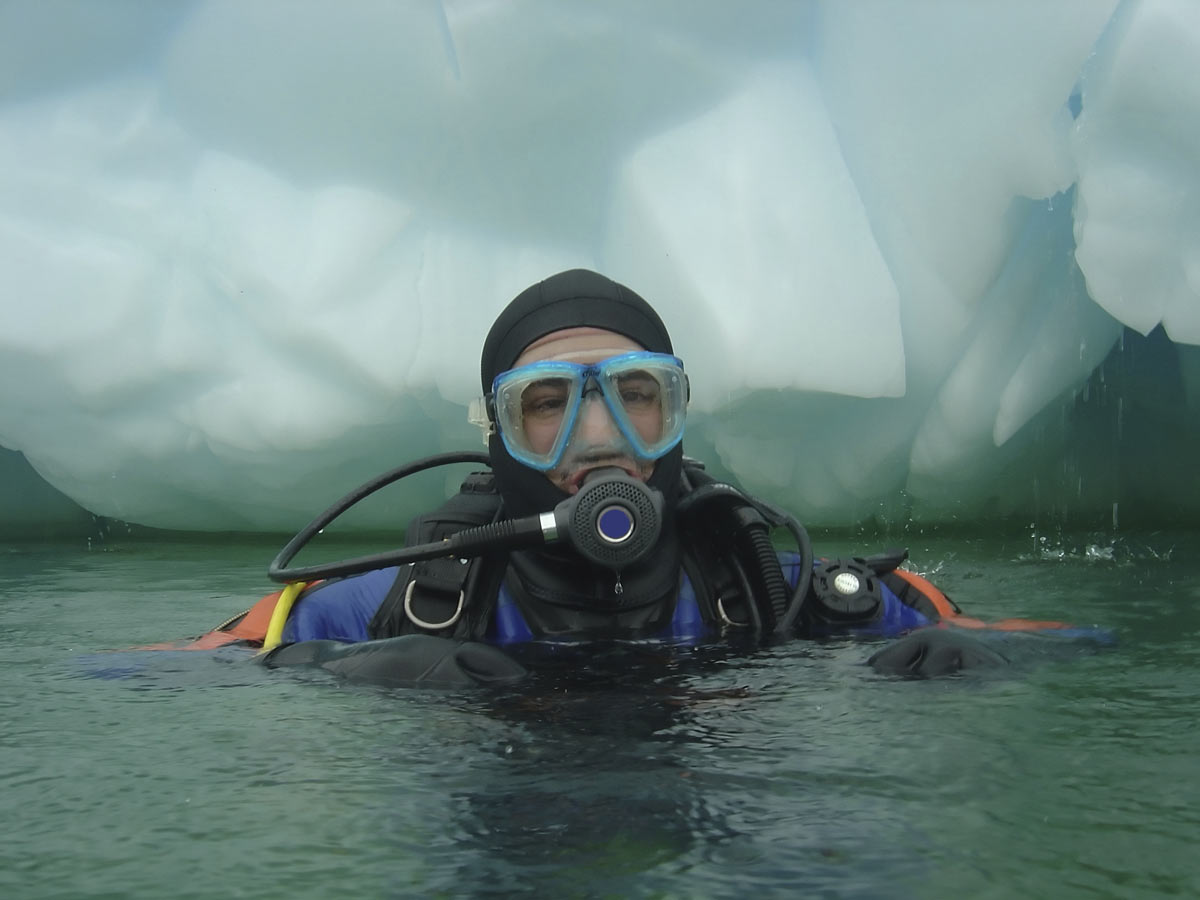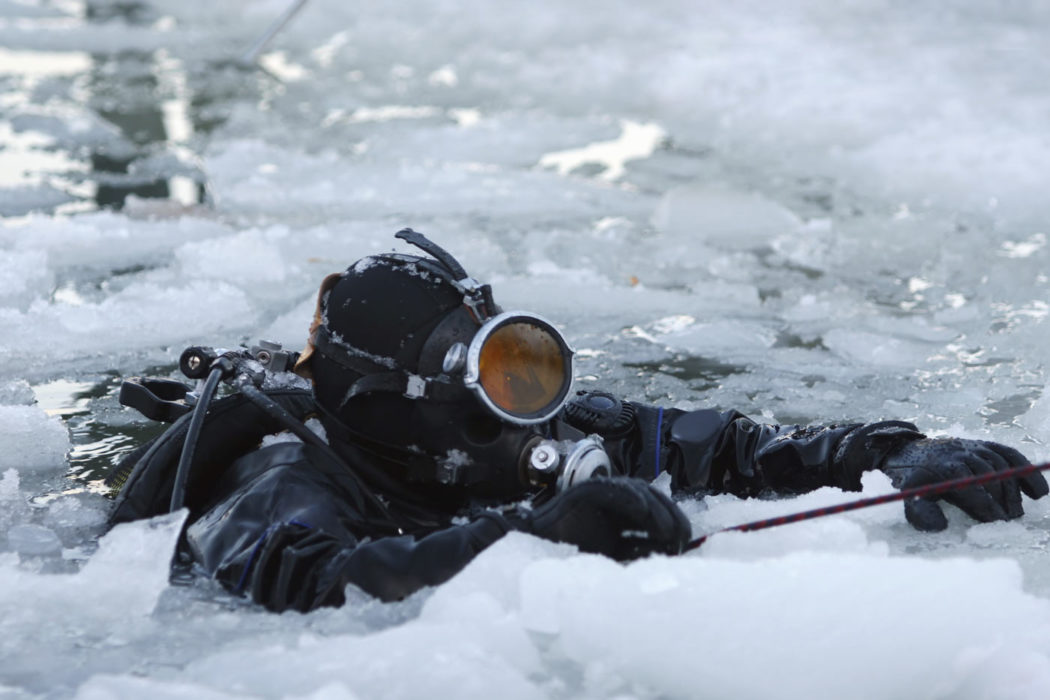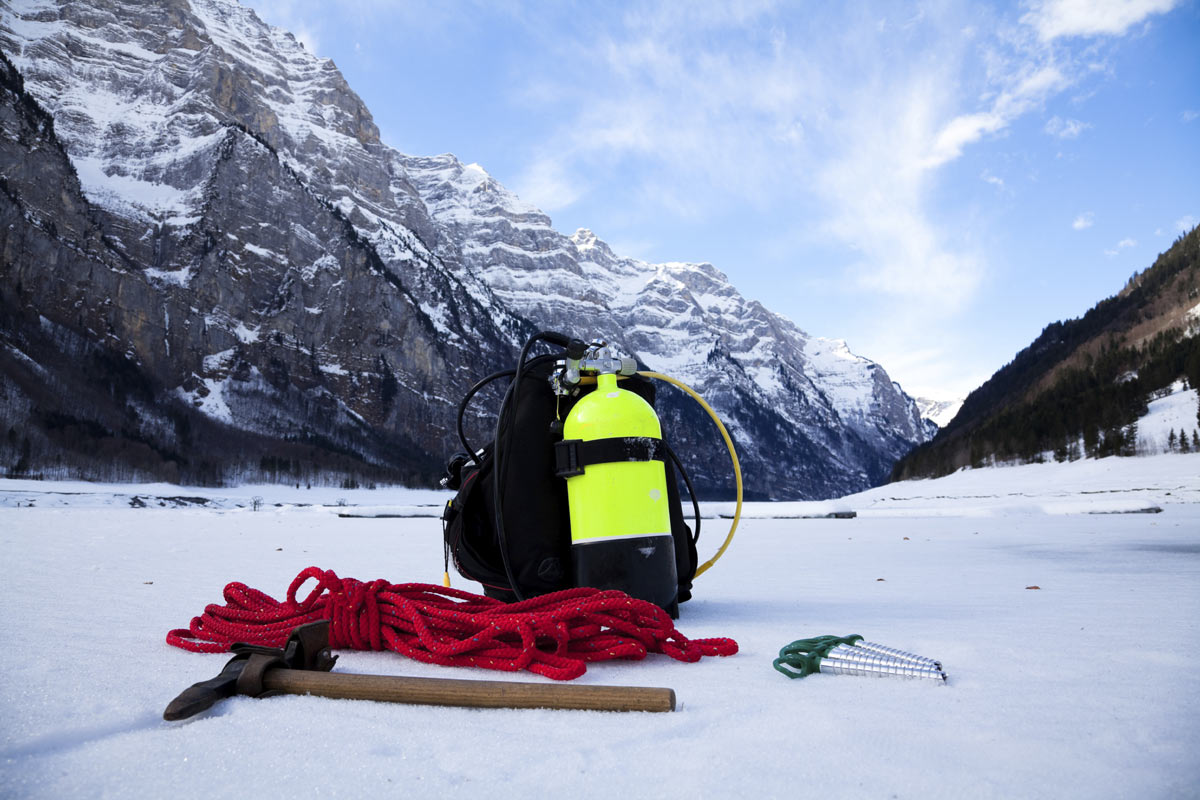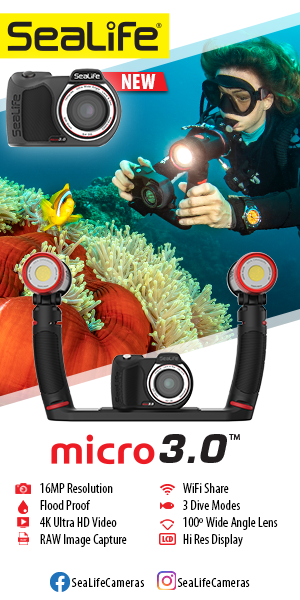An old dive buddy of mine says, “I prefer my beer cold and my ocean warm — not the other way around.” I must admit, I agree with him. Clearly, ice diving isn’t for everyone. But for some hardy souls, it’s an adventure not to be missed. Once you are trained and equipped with the proper gear, ice diving has its rewards.
Preparation
Ice diving is not something that you do on the spur of the moment; it is a serious endeavor that requires special training. The duration, number of dives and even academic content of Ice Diving specialty courses vary significantly depending on the instructor, the training agency and even the location where you plan to dive.
To participate in most Ice Diving specialty courses you must be at least 18 years old and possess an Advanced Diver rating, or equivalent. Some courses also require a prerequisite minimum number of dives that exceeds the minimum number a diver typically accumulates reaching the Advanced level.
There is a lot to learn about ice diving. Even after completing the specialty rating it is advantageous to continue the learning curve under the watchful eye of a dive professional during dive center-sponsored ice dive outings.
If you are already accustomed to diving in cold water you are a step ahead. As you can surmise, water beneath the ice is cold, but not a lot different from the deep thermocline temperatures experienced year-round in many quarries and lakes.
Being a certified dry suit diver is a plus as well. Even though it is possible to venture beneath the ice wearing a wet suit, you will be significantly more comfortable in a dry suit. Either way, if you are not “dry suit trained” and haven’t ever dived in cold water, it would be in your best interest to expand your diving education to include those two adventures before thinking about slipping beneath the ice.
Since ice diving takes place beneath an impenetrable ice ceiling through which a diver cannot make a direct ascent to the surface, it is considered an overhead environment, similar to cave and wreck penetration diving. The question regarding whether ice diving should be classified as recreational or technical continues to be debated. Either way, to ice dive safely requires specialty training, astute basic scuba skills and special equipment.
Diving beneath an ice cap with only a single hole for exiting is not a good time to be testing rusty scuba skills. A diver’s basic skills, especially buoyancy control and air management, should be well-honed before embarking on an ice dive. Even experienced divers who haven’t used their skills in a while should do a skill review before engaging in ice diving training.
Even when you are properly trained and have fine-tuned your skill sets, ice diving is not something that you and your buddy just go out and do; it is a team undertaking. An ice dive outing typically requires a minimum of five divers and an additional safety line tender — one buddy team diving beneath the ice, a line tender for each diver, a safety diver suited up and standing ready at the entry hole and a line tender (not required to be a diver) for the safety diver.
Once you have a team together, an ice diving outing still requires significant logistical planning. First there is the question of where and when; this depends on weather and ice conditions. Unsafe ice is dangerous and harsh weather conditions can be punishing.
Then there is equipment. Not only must ice divers have the proper thermal protection and environmentally sealed regulators, but also the outing requires things like cutting tools for making an entry/exit hole, a means for clearing the surface of snow, tender lines, rescue lines and safety equipment.

When diving in extreme cold, both your primary and safe-second regulators should be environmentally sealed, which makes them less susceptible to freeze-up in cold conditions. To further avoid freeze-up, do not breathe from your primary regulator while at the surface.
Equipping for Ice Diving
Ice diving is an equipment-intensive sport, and planning and conducting an ice dive outing is even more involved. Ice divers must be equipped with specialized scuba gear that is appropriate for the cold-water environment and often harsh surface conditions. Let’s begin with thermal protection.
Even though it is possible to ice dive wearing a wet suit, for optimum warmth and comfort a dry suit is highly recommended. And, of course, a hood and gloves, preferably dry gloves, are required.
Diving in an overhead environment limits an ice diver’s emergency response options. That is why a fail-safe air source — a supply-and-delivery system — is even more critical when diving beneath the ice.
Regulators used for ice diving (or any seriously cold water) must be environmentally sealed, making them less susceptible to freeze-up and freeflow. Before engaging in ice diving, confirm with your local dive center that the regulators you plan to use are environmentally sealed and suited for use in cold conditions.
Beneath the ice, redundancy is the key to survival. Since an ice diver’s surfacing options are limited he or she must be prepared to resolve emergencies without requiring emergency ascent.
As a safety precaution every ice diver should be equipped with at least two first-stage regulators. In the rare event that a regulator malfunctions (typically caused by freezing) the diver can switch to the other by picking up the second-stage regulator that is connected to the functioning first stage.
Diving with a single cylinder requires a valve modification that allows both first-stage regulators to be mounted on the same tank. Many ice divers use double tanks, which provide both redundant air supplies and delivery systems.
Before and between dives scuba gear, especially the regulators, should be kept dry and in a warm environment. Once mounted on the tank the regulator is tested by inhaling through the second stage(s), but then not exhaling until the second stage has been removed from the mouth; this prevents moisture in exhaled air from entering the regulator.
The regulator should not be tested or breathed from again until you have entered the water and submerged. Underwater the chance of freeze-up is not as likely, but just to be safe, if the regulator needs purging while at depth exhale forcefully through the mouthpiece rather than depressing the purge button.
Upon exiting do not breathe from the regulator once your head breaks the surface. After disassembling the scuba unit return the regulator systems to a warm environment, if possible. After changing to a full tank, avoid breathing through the regulator until you are submerged on the next dive.
For safety and communications purposes ice divers are tethered to the surface via a line that is tended by support personnel stationed near the entry/exit opening in the ice. Therefore, every ice diver must have a means to securely attach the tether line.
Some divers fasten it to a D-ring on the buoyancy compensator (BC); others use a D-ring located on the back plate where the cylinder is mounted. A highly recommended tether technique, however, is a specially designed ice diving harness that is worn beneath the BC. Most harnesses have a D-ring on the front where the tether line can be attached and easily accessed.
Redundancy also applies to accessory gear like lights and cutting tools.
A standard dive mask is adequate for ice diving. However, masks fog more easily in cold water, especially when saliva is used as a defog solution, so always defog the mask using a commercial solution.
Ice diving is not just about getting wet; as mentioned earlier, it involves a number of above-the-ice support personnel, who also must be properly trained and equipped.
Each diver is tethered using a line that is tended by a diver on the ice. The typical tether line is 3/8 to ½ inch (1-1.3 cm) polypropylene (it floats) that is roughly 150 feet (45 m) long. Although some ice divers tether both members of the buddy team on a single line, a separate tether line for each diver is more typical.
Line tenders are dressed in thermal protection — wet or dry suits — in case they need to enter the water to help a surfaced diver exit.
Ice screws typically are used to secure the end of each line to the ice a few feet away from the hole. This guards against the entire line accidentally being pulled into the hole, leaving the tethered diver without a way to communicate or find his way back to the exit opening.
The stand-by rescue diver is staged at the edge of the hole and ready to enter the water on a moment’s notice. He is dressed in a dry suit with all accessory gear in place. His scuba unit is nearby and poised for immediate donning. A trained support person stands ready to tend the rescue diver’s rescue line, if needed.
Snow shovels and cutting tools are needed to clear the area and cut the entry/exit hole in the ice. A chainsaw is commonly used, as are handsaws and drills. The edges of the hole(s) should be smooth to avoid diver injury or equipment damage during entry and exit.
Ice diving teams often erect a tent or similar on-ice base camp shelter near or even over the hole in the ice to protect personnel and equipment from the wind, cold and snow that frequently accompanies ice diving.
Safety Concerns
Ice diving is a rewarding, but potentially dangerous undertaking. Diving in near-freezing water beneath an impenetrable ice ceiling with a single-exit hole requires that everything function as planned. When it doesn’t, serious consequences can occur.
Many problems encountered by inexperienced ice divers are mental. The ceiling, combined with only one way out, plays games in one’s mind. The fact that ascending directly to the surface is not an option heightens any claustrophobic tendency.
The most common physical problem encountered by ice divers is hypothermia. Many cold divers ignore the danger signals and end up sacrificing their motor skills. Numb extremities and a shivering body core is a serious condition, especially when beneath the ice.
Air management is another concern. Three factors contribute to a diver’s increased air consumption while ice diving. First is the cold. When your body is working hard to stay warm you breathe more rapidly and consume more air.
The same is true when your excitement level rises, and if diving beneath a sheet of ice with a single escape route doesn’t excite you, nothing will.
The third factor is that you are aware that you are breathing more air than normal. Just the thought of running out of air is enough to make you breathe more rapidly.
Equipment problems are another concern, the most common being regulator freeze-up, which typically results in uncontrollable freeflow. If this occurs, switch to the second-stage regulator that is connected to the back-up first stage. Then close the valve to the malfunctioning first stage and terminate the dive.
Becoming detached from the tether line also is an equipment concern. If you have traveled far enough from the entry opening that you can no longer clearly see it, losing the tether line means you don’t have a clear reference to the exit. However, you still have your buddy nearby and hopefully he has not lost his tether. If a tether line is lost the dive should be terminated.
These are safety concerns that every diver should consider. Although individual divers may view and react to these situations differently they may also have their own concerns. However, if you are aware of safety issues you can be prepared to deal with them appropriately.
Ice Diving Technique
Diving with an organized ice diving group from a dive center relieves the recreational ice diver of significant upfront responsibility. However, if your ice diving team is without the supervision of a dive professional or highly experienced ice diver you must make a number of important decisions on your own.
The first is making sure that the ice is sufficiently thick to support your dive team and equipment. The ice depth must be confirmed to be safe before a base camp is established and an access hole(s) cut.
There are a number of tools that can be used to cut the opening, but a chainsaw is most common. Anyone using the saw must be trained in its use for cutting ice.
Typically the entry/exit hole is an equilateral triangle with 6-foot (2 m) sides or a 6-by-3-foot (2-by-1-m) rectangle. Many ice divers favor a triangle because it provides easier entry and exit.
Depending on water visibility and available sunlight, ice diving teams sometimes create a pattern on the ice surface that helps the divers orient themselves with the hole. Using the hole as the axis, the team clears circular paths in the snow at progressively farther distances from the hole. They then connect the outer edge of the circle with the hole by clearing several radial paths. Divers looking toward the surface can use the light penetrating the shoveled pattern to orient themselves with the exit location.
Before diving begins, tether and safety lines must be set up. The outer end of each line is secured to the ice several feet back from the hole and the line coiled or laid out straight on the ice. It is common for each diver to have a separate tether line, although some ice divers use one line per buddy team.
Typically only one buddy team dives at a time, while a second buddy team tends their tether lines. A third rescue diver stands suited up and ready to enter the water if a problem arises beneath the ice. An additional line tender is poised to tend the rescue diver’s safety line if he enters the water.
Once the lines are in place the first buddy team gears up, performs a buddy check and the tether lines are attached to their harnesses. They then enter using a controlled seated entry from opposite corners of the hole. Throughout the dive the line tenders pay out or take up line as required and communicate with the divers using line pulls.
To avoid interfering with the tether lines and communication process, streamlining is especially important when diving beneath the ice. All accessory items, gauge consoles and second-stage regulators should be secured in an accessible location close to the body.
Air management is an important part of ice diving as well. Beneath the ice divers typically apply the rule of thirds (or an even more conservative approach) — use the first third of the air supply exploring in a direction away from the entry hole; the second third heading back to the exit location and, if everything goes as planned, the remainder of your discretionary air supply nosing around beneath the exit hole. This leaves one-third of the supply available in case a problem arises before you reach the exit.
At the end of the dive the divers return to the exit hole and are assisted back onto the ice by the line tenders and other support personnel.
As the exiting divers doff their gear and take a short break to warm up, the line tender team gears up and prepares to enter the water. For this dive the roles are reversed; the former line tenders dive, while the first buddy team, still in their dry suits, tends the lines.
Ice dive bottom times are conservative; 15-30 minutes is typical.
The techniques used for ice diving vary significantly among instructors, training agencies and by location. Regardless of which technique you learn it is important that you closely follow the rules and perform the techniques safely.
Under-Ice Communications
As long as underwater visibility is good, and it usually is under the ice, communication between divers is the same as when diving in open water. However, ice divers and their line tenders apply a different system of communications, one using the tether line and a predetermined set of line pulls.
Following is an example of commonly used line signals, which are always acknowledged by the recipient on the other end:
Tender to Diver
One pull means: “Are you alright?”
Or, if diver is descending, “Stop.”
Two pulls mean: “OK to continue.”
Three pulls mean: “Stand by to ascend.”
Four pulls mean: “Ascend.”
Diver to Tender
One pull means: “I am alright.”
Two pulls mean: “Give slack.”
Three pulls mean: “Take up slack.”
Four rapid pulls mean: “Pull me up!”
The Allure of Ice Diving
At this point you may be thinking that ice diving seems like a lot of work. So why do people do it? The answer varies greatly between divers.
For other than police and fire rescue-and-recovery teams, the most common answer is adventure. Sinking beneath a layer of ice with only one way out is stimulating, to say the least, and the frigid waters are nothing short of invigorating.
Visibility beneath ice typically is excellent. You can count on being able to see at least three to 10 times farther than when diving the same location without ice cover. In many locations the filtered light from above is simply breathtaking as long shafts of sunlight radiate toward the depths.
The marine life you encounter when ice diving depends on where you dive, but you can count on fishes moving more slowly and possibly venturing closer. With the improved visibility you’ll likely see things you haven’t before noticed.
RELATED READ: UNDERSTANDING COLD WATER CORALS
For those hardy souls from northern climates who just can’t stay out of the water, ice diving provides a year-round activity. Dressed in a dry suit with chainsaw in hand, they dive every weekend regardless of the weather.
Another common reason for taking an Ice Diving course is bragging rights. According to ice diving instructors, a fair number of recreational divers earn an Ice Diving specialty rating just so they can say that they have done it.
Regardless of their reasons, an astounding number of divers are drawn to diving beneath the ice.
Opportunities
Ice diving can be done anywhere that the water surface freezes to a thickness of a foot or more and stays that way for a while. Depending on winter temperatures, some locations experience a narrow window of ice diving opportunity; whereas the farther north you go the longer the season.
Dive centers where ice diving is possible typically schedule outings whenever conditions are right. I know a number of dive centers that have a longstanding tradition of ice diving on New Year’s Day.
Ice diving is not, however, limited to local diving. Antarctica is an emerging ice diving destination. Just as warm-water divers flock to live-aboard vacations in the tropics, weeklong ice diving tours are available where ice thickness is measured in yards and visibility in hundreds of feet.
Conclusion
Ice diving is a dangerous sport, but one that involves challenging adventure for those who are adequately trained and properly equipped.
This article provides a brief look into this intriguing specialty, but is in no way intended to prepare a diver to venture beneath the ice, or to take the place of professional ice diving training. For more information about an Ice Diving specialty course, contact your local dive center.







